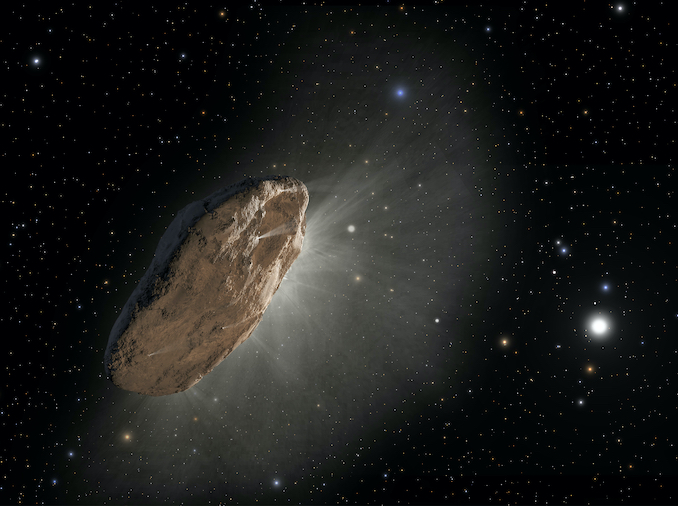The mysterious interstellar object 1I/’Oumuamua, which was discovered in October 2017 as it hurtled through our Solar System at 26 kilometres per second relative to the Sun, could have formed when its parent body was pulled apart by gravitational tides from a star, resulting in elongated shards being ejected into interstellar space.

’Oumuamua was the first of its kind in several ways. Astronomers had predicted that there should be objects with interstellar origins passing through our Solar System, but the expectation was that these objects should be comets. Since icy cometary bodies generally reside near the outer edge of planetary systems where they feel their star’s gravity only loosely, their orbits prone to being deflected by the gravitational influence of nearby planets or close-passing stars, then it should be a relatively simple process to kick comets into interstellar space.
However, ’Oumuamua didn’t look like a comet. It had no coma (the name of a comet’s extended ‘atmosphere’ of dust and ice particles liberated from its surface by solar heating) or tail when it passed through the Solar System. Its shape was also bizarre; measuring somewhere between 100 metres and a kilometre in length, ’Oumuamua was long and shard-like, being between five and ten times greater in length than in width. Nothing else currently known in the Solar System sports a shape that is so elongated. The only hint that ’Oumuamua might be a comet was the fact that its trajectory away from the Sun was altered in the same way that a comet’s trajectory alters as a result of outgassing giving it a nudge. However, no outgassing was detected, compounding the puzzle.
Ripped to shreds
Astronomers have been grappling with the puzzle of ’Oumuamua since it was discovered, but now Yun Zhang of the National Astronomical Observatories of the Chinese Academy of Sciences, and Douglas Lin of the University of California, Santa Cruz, think they have figured it out. Writing in the 13 April issue of the journal Nature Astronomy, they describe detailed computer simulations that replicate a feasible process by which ’Oumuamua could have formed and gained its distinctive characteristics.
Their simulations show how an object – be it a large comet, an asteroid, even a rocky planet – can be ripped into long fragments by gravitational tides when it passes too close to its star. These elongated fragments are then given a gravity assist as they whip around their star that accelerates them out of the system and into interstellar space.
Depending on the material that the object is composed of, and its density, “The ratio of long axis to short axis can be even larger than ten to one, ” says Zhang.

Furthermore, the close encounter with its parent star and the resulting fragmentation also explains why ’Oumuamua didn’t behave much like a comet. As the object breaks up, the surface of each fragment melts in the heat of the star. As the elongated fragments gradually move away from their star, they refreeze, creating a stiff crust that helps each fragment retain its structural stability. The heating causes the water- and carbon-dioxide ice on the surface to sublimate away, explaining why ’Oumuamua did not have a coma or a tail, but there should still be some water buried deep within the fragments. The outgassing of this buried water would explain why ’Oumuamua’s trajectory through the Solar System mirrored that of an outgassing comet.
A hundred trillion ’Oumuamuas
When ’Oumuamua was discovered, David Jewitt of the University of California, Los Angeles, estimated that there could be as many as 10,000 other interstellar bodies passing through our Solar System at any one time. A second visitor from the stars has since been discovered – 2I/Borisov, which is now breaking up – but Borisov definitely was comet-like, with a coma and a tail. So there seems to be at least two populations of interstellar interlopers, namely the elongated fragments like ’Oumuamua, and the cometary bodies such as Borisov.
“The discovery of’Oumuamua implies that the population of rocky interstellar objects is much larger than we previously thought,” says Zhang. “On average, each planetary system should eject in total about a hundred trillion objects like ’Oumuamua.”
Zhang and Lin’s model has drawn support from other astronomers, including Matthew Knight of the US Naval Academy, who co-leads the multinational ’Oumuamua team at the International Space Science Institute along with Alan Fitzsimmons of Queens University Belfast. Knight says that the new model “does a remarkable job of explaining a variety of unusual properties of ‘Oumuamua with a single, coherent model.”
All eyes now turn towards future discoveries. The Vera C. Rubin Telescope (formerly the Large Synoptic Survey Telescope) is expected to discover hundreds of interstellar visitors, and will provide the first opportunity to test whether Zhang and Lin are correct in their proposal that a large selection of interstellar objects share the characteristics of ’Oumuamua.



